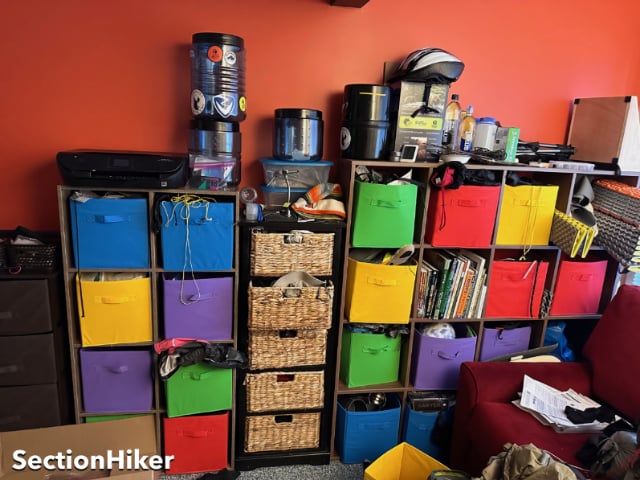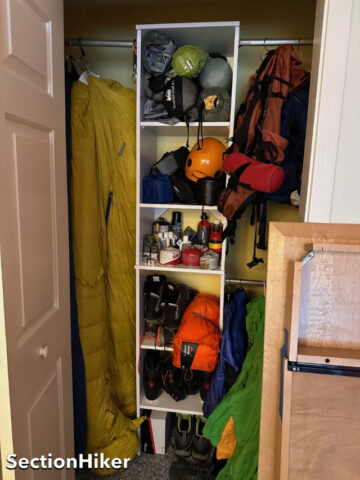If you own a lot of hiking and backpacking gear, it pays to keep it well-maintained and organized so you can find what you need when packing up for a hike or a trip. Here are some tips and tricks that I use to store my gear, so it doesn’t take over my home, and so I can find what I need quickly when preparing for a new adventure. Everybody does this differently, so if you have a useful suggestion you want to share, please comment below.

Get Rid of Stuff You Don’t Need or Never Use
I own a fair amount of hiking and backpacking gear, but probably less than you might guess given the enormous amount that I review and write about on SectionHiker.com. That’s because I make a point to give away most of the free samples that manufacturers send me to review. There’s no point in keeping gear that you never use, so I try to avoid hanging onto things just for the sake of keeping them. I give most of the free gear I get to friends and acquaintances, and I know they pass it further along to their friends.
If you’ve purchased gear that you don’t use anymore, there are lots of places to sell it online in Facebook groups, on Reddit, or on eBay. You can even send trade it in at REI for store credit, which is convenient and quite easy to do, but won’t generate as much income as selling it online.
Create a Designated Gear Space or Room
It really helps to store all of your outdoor gear in one central place or room. For example. I store all my hiking and backpacking gear in my spare bedroom. This helps reduce the clutter in the rest of my living space. When I get home from a hike or trip, I take off my pack in that bedroom to keep the “gearplosion” contained and prevent items from being misplaced. It takes a little discipline, but it really helps keep me organized and minimize complaints from my roommate. I also keep all of my Tenkara fishing gear and fly-tying supplies in this room, as well as a small desk, that mainly gets used for tying flies. The only things not stored in my gear room are my cross-country skis, which hang in my front hallway close to the front door.

Group Items in the Same Category Together
I group my gear into categories and store it all together. For example, all of my stoves are stored in the same bin. The same goes for my water filters/hydration reservoirs, stuff sacks, insoles, stoves, cookpots, gloves, gaiters, hats, and so forth. I like to use different gear for different trips and this lets me see what I have and pull out the items I want easily.
Spares and Consumables
I do keep some spare items and consumables out of convenience and these are also grouped together. There are items I break periodically that are difficult to source quickly like replacement trekking pole segments, Tenkara fishing pole tips, and Hillsound Trail Crampons (I routinely break 1-2 pairs each winter). I also keep a stock of Isobutane fuel canisters, Esbit cubes, tenacious tape, Picaridin, and Permethrin around because I use them up during the year, so it’s nice to have a resupply at hand.

Cloth Cubes, Shelving, and Hanging Storage
I’ve tried a number of different storage formats over the years, but the one that’s worked the best (and I use now) involves fabric cubes with shelving and a ClosetMaid closet system with a central shelving pillar and three hanging racks. I like it because I can store a relatively large amount of gear in a small amount of space, everything stays clean and dust free, and it’s very easy to access items when I want something.
Cubes/Shelving: For example, I store all my water filters/hydration reservoirs, stuff sacks, insoles, stoves, cookpots, gloves, gaiters, and hats in cloth cubes that fit into a bookcase designed for that purpose. I also use those cubes to store hammocks and their suspension systems as well as winter traction aids like trail crampons, microspikes, and full crampons. Wayfair is a good place to buy these cube/shelving units and they’re relatively easy to assemble.
Closet System: I store tents, sleeping pads, footwear, and some of my loose spare consumables in the central shelving pillar. This is very efficient in terms of space utilization because you can store items from the floor up to the ceiling.

This closet system also has three bars that I hang things on. For example, my sleeping bags and quilts all hang on the left-hand side and can loft fully without deteriorating the insulation. I tried storing them in the cloth sacks supplied by the manufacturers, but that was really ungainly because they were always toppling off the shelves that they sat on.

I hang backpacks from the top bar on the right-hand side and jackets and vests on the bottom bar. The backpacks and the sleeping bags are hung using hooks, also available from Wayfair. I love these hangers: I often have a half dozen or more backpacks in various stages of review and hanging them up frees up a lot of the floor space they’d otherwise occupy.

Wire Wastebaskets
I store my Tenkara fishing rods, umbrellas, trekking hole spares, and my ice axe in wire wastebaskets. These are good for organizing long skinny items. I can’t remember where I saw it, but some people use pool cue racks to hang their rods on the wall. I’ve considered that, but I dread bashing holes in my drywall to get to the studs. Wastebaskets are considerably simpler and more portable if you decide you want to move them someplace else.

While I do own a lot of gear, this system works very well at keeping it organized and off the floor – which is one of the secrets of an uncluttered house. But it takes some discipline to keep it way. The trick is to unpack your gear after you’ve used it, dry it, and put it away. If you do that, your house or apartment will be much tidier and more livable, and packing for your next adventure will be a piece of cake.
SectionHiker is reader-supported. We independently research, test, and rate the best products. We only make money if you purchase a product through our affiliate links. Help us continue to test and write unsponsored and independent gear reviews, beginner FAQs, and free hiking guides.
